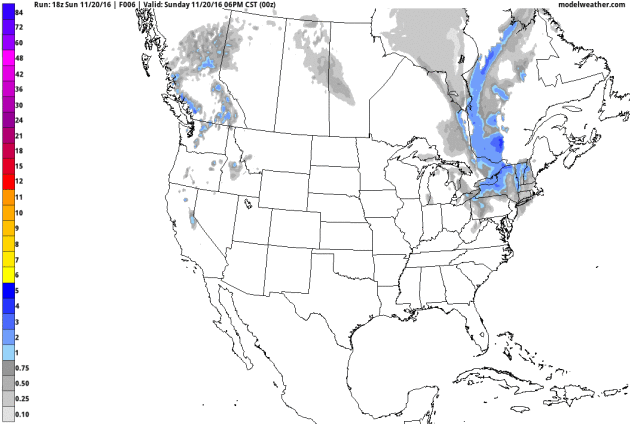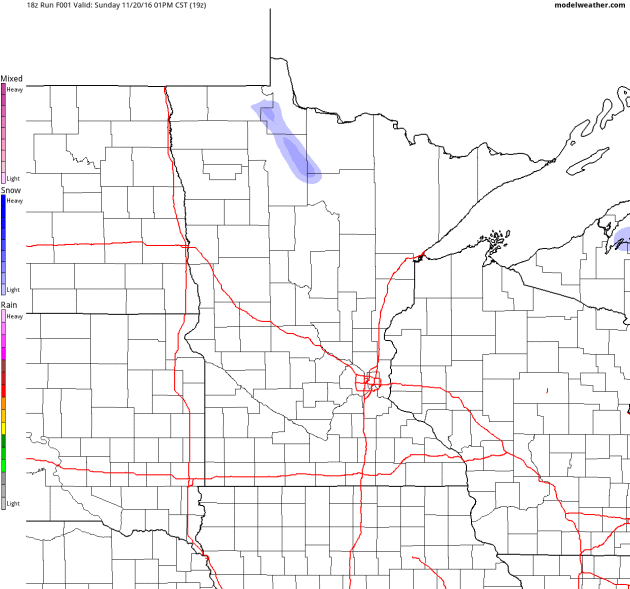36 F. average high on November 20.
28 F. high on November 20, 2015.
November 21, 2001: Record highs are set in west and north central Minnesota, ranging from the upper fifties to lower sixties. Redwood Falls set their high with 68 degrees Fahrenheit and Little Falls had a high of 65 degrees.
November 21, 1980: On this date, around 28 thousand Canadian geese spent their nights on Silver Lake in Rochester.

Trending Colder, Stormier and Snowier
Job security. Hey, if the weather didn't change every once in a while I wouldn't have a business, and we wouldn't have anything to chat about. Murphy's little know 4th corollary states that "storms, given a choice, PREFER to come on major holidays."
Uncanny but true. For the same reason it rains (hard) on Saturdays and thunders during outdoor wedding ceremonies. Mother Nature has a wicked sense of humor.
No problems today, but a long fetch of moisture from the Gulf of Mexico squeezes out a few inches of wet, slushy snow Tuesday - mixing with sleet and freezing rain.
Surface temperatures should be close to 32F, so freeways may be wet/slushy, but this could be a plowable pile of sloppy snow from the Twin Cities on north by Tuesday night.
Flurries give way to slow clearing Wednesday with a dry sky for Thanksgiving Day. We may wake up to flurries Friday morning but I don't see major drama on the highways. Light snow may slush up a few roads Sunday, but models hint at a major storm the middle of next week; a mix changing to snow.
Old Man Winter is back and possibly making up for lost time.
GFS predicted snowfall into midday Saturday above courtesy of NOAA and AerisWeather.

U.S. Launches Revolutionary Weather Satellite. The Washington Post has more clarity and background on what makes GOES-R a massive step forward for the science of meteorology: "...The “camera” instrument on GOES-R — called the Advanced — doubles the resolution of the current NOAA satellites. It can scan the whole hemisphere in five minutes, and if there’s a particularly dangerous weather pattern approaching, forecasters can scan a smaller region over the United States every 30 seconds. Sudden bursts of lightning could mean thunderstorms are becoming severe. So, GOES-R has a lightning mapper to continuously monitor and transmit all of the lightning strikes across North America and the surrounding oceans..."
Image credit: "Schematic of GOES-R with instruments labeled." (NOAA/NASA).
What's It Like To Fly Into The Eye of a Hurricane? Here's an excerpt of a fascinating chronology of a Hurricane Hunter flight into "Matthew", courtesy of NOAA AOML: "...We
started bouncing up and down at a much faster rate, much like a very
intense wooden roller coaster, as I tried to contain my stomach from
getting too upset. As we pounded through the eyewall and made it into
the eye, what I saw and experienced was truly breathtaking; thick white
clouds above and below as far as the eye could see as blue skies and
ocean attempted to pierce through, the turbulence experienced just
moments prior was quickly winding down, and a sense of calmness
surrounded us as we entered the eye of Hurricane Matthew. I was so taken
aback by the magnitude of what I was seeing that I almost forgot to do
my job and immediately started taking pictures and videos of the eye..."
Photo credit: "The eyewall of Hurricane Matthew as the aircraft was making a pass through." Image credit: NOAA.
Photo credit: Helen H. Richardson, The Denver Post. "Victor Muffat-Jeandet of France races in the first run of the giant slalom FIS World Cup Birds of Prey race in Beaver Creek on Dec. 6, 2015."
Photo credit: U.S. Forest Service. "Dead pine trees dominate a hillside in the Los Padres National Forest, north of Frazier Park."
Earthquakes: Reckoning With The Big One in California - And It Just Got Bigger. Here's a good summary of a recent study at The Wall Street Journal: "...For years, scientists believed the mighty San Andreas—the 800-mile-long fault running the length of California where the Pacific and North American plates meet—could only rupture in isolated sections. But a recent study by federal, state and academic researchers showed that much of the fault could unzip all at once, unleashing a rare, singular catastrophe. Now, insurers have used that research to come up with a new analysis of the damage that could be caused by statewide break of the San Andreas..."
Photo credit above: "A 6.7-magnitude earthquake struck the Northridge suburb of Los Angeles in 1994, causing 57 deaths and $20 billion in property damage. Researchers say a statewide quake above 8.0 could cause $289 billion in damage just to homes alone." Photo: AP
Major
Hurricane Joaquin is shown at the far eastern periphery of the GOES
West (GOES-15) satellite’s full disk extent, taken at 1200Z on October
1, 2015. Credit: NOAA
Read more at: http://phys.org/news/2016-11-noaa-goes-r-satellite.html#jCp
Read more at: http://phys.org/news/2016-11-noaa-goes-r-satellite.html#jCp
Major
Hurricane Joaquin is shown at the far eastern periphery of the GOES
West (GOES-15) satellite’s full disk extent, taken at 1200Z on October
1, 2015. Credit: NOAA
Read more at: http://phys.org/news/2016-11-noaa-goes-r-satellite.html#jCp
Read more at: http://phys.org/news/2016-11-noaa-goes-r-satellite.html#jCp
We Really Need To Figure Out How To Stop a Killer Asteroid, Scientists Say. Here's a clip from The Washington Post: "...NASA has discovered some 17,000 potentially hazardous near-Earth objects, but none of them is projected to come close to Earth in the next hundred years. No human that we know of has been killed by a meteorite or the effects of an impact, and the likelihood that this could happen to any of us is very, very slim. The chance of an impact big enough to destroy our planet is even smaller. Remember that Earth has suffered only one mass extinction-inducing impact that we know of in its 4.6 billion-year history, and even that asteroid didn't end life entirely. Our planet is pretty resilient. Still, plenty of researchers don't want to simply wait around and see what happens..."
Image credit: "Last month, NASA performed a simulation of what might happen if an asteroid was on a collision course with Earth." (NASA).
Quit Social Media, Your Career May Depend On It. Are we distracting ourselves to death? Here's an excerpt from an interesting essay at The New York Times: "...The
idea that if you engage in enough of this low-value activity, it will
somehow add up to something of high value in your career is the same
dubious alchemy that forms the core of most snake oil and flimflam in
business. Professional success is hard, but it’s not complicated. The
foundation to achievement and fulfillment, almost without exception,
requires that you hone a useful craft and then apply it to things that
people care about. This is a philosophy perhaps best summarized by the
advice Steve Martin used to give aspiring entertainers: “Be so good they
can’t ignore you.” If you do that, the rest will work itself out,
regardless of the size of your Instagram following..."
How Social Media Broke Democracy.
We are lost in our social media news consumption bubbles, and this
makes it harder to empathize with others? Here's an excerpt of a
thought-provoking essay from Tobias Rose-Stockwell at Medium: "...Facebook has stated that their mission is to make the world a more open and connected place. And they have, by anyone’s measure, connected more humans than any company in history.
With this success, they have also created a tool that has allowed us to
become more insulated in our own ideological bubbles than we ever have
been before. Because of this lack of pluralism, we are systematically losing our ability to empathize.
This is what we now see in the wider world — from Brexit to Trump to
hyper-nationalistic movements worldwide. People globally no longer have
the same incentives to find a shared understanding. This is not just
dissatisfaction with globalization or the status quo. This is how we are changing our society by not seeing each other..."
Image credit: Wall Street Journal's Blue Feed, Red Feed. Check out the different in tone, style and "facts" for the same topic.
Dancing in a Hurricane. Thomas Friedman explains our collective angst and paranoia in an Op-Ed at The New York Times: "...So no wonder many in the West feel unmoored. The two things that anchored them in the world — their community and their job — are feeling destabilized. They go to the grocery store and someone there speaks to them in a different language or is wearing a head covering. They go into the men’s room and there is someone next to them who looks to be of a different gender. They go to work and there’s now a robot sitting next to them who seems to be studying their job. I celebrate this diversity of people and ideas — but for many others they’ve come faster than they can adapt..." (Image: GE Reports)
MONDAY: Partly sunny, dry. Winds: SE 7-12. High: 38
MONDAY NIGHT: Clouds increase. Low: 31
TUESDAY: Wet snow and ice. 2-4" slush possible. Winds: SE 10-15. High: 34
WEDNESDAY: Light snow tapers, another inch? Winds: NW 10-15. Wake-up: 30. High: 35
THURSDAY: Mostly cloudy, probably dry. Winds: NW 5-10. Wake-up: 28. High: 37
FRIDAY: Morning flakes, then drying out for power-shopping. Winds: NW 8-13. Wake-up: 29. High: 38
SATURDAY: Peeks of sun, better travel day of the weekend. Winds: SE 10-15. Wake-up: 27. High: near 40
SUNDAY: Light snow and flurries. Winds: NW 8-13. Slick spots. Wake-up: 29. High: 37
Climate Stories
Photo credit: Pascal Sittler/REA/Redux. "Rex Tillerson, CEO of ExxonMobil, at the World Gas Conference, Paris, June 2015."

No comments:
Post a Comment